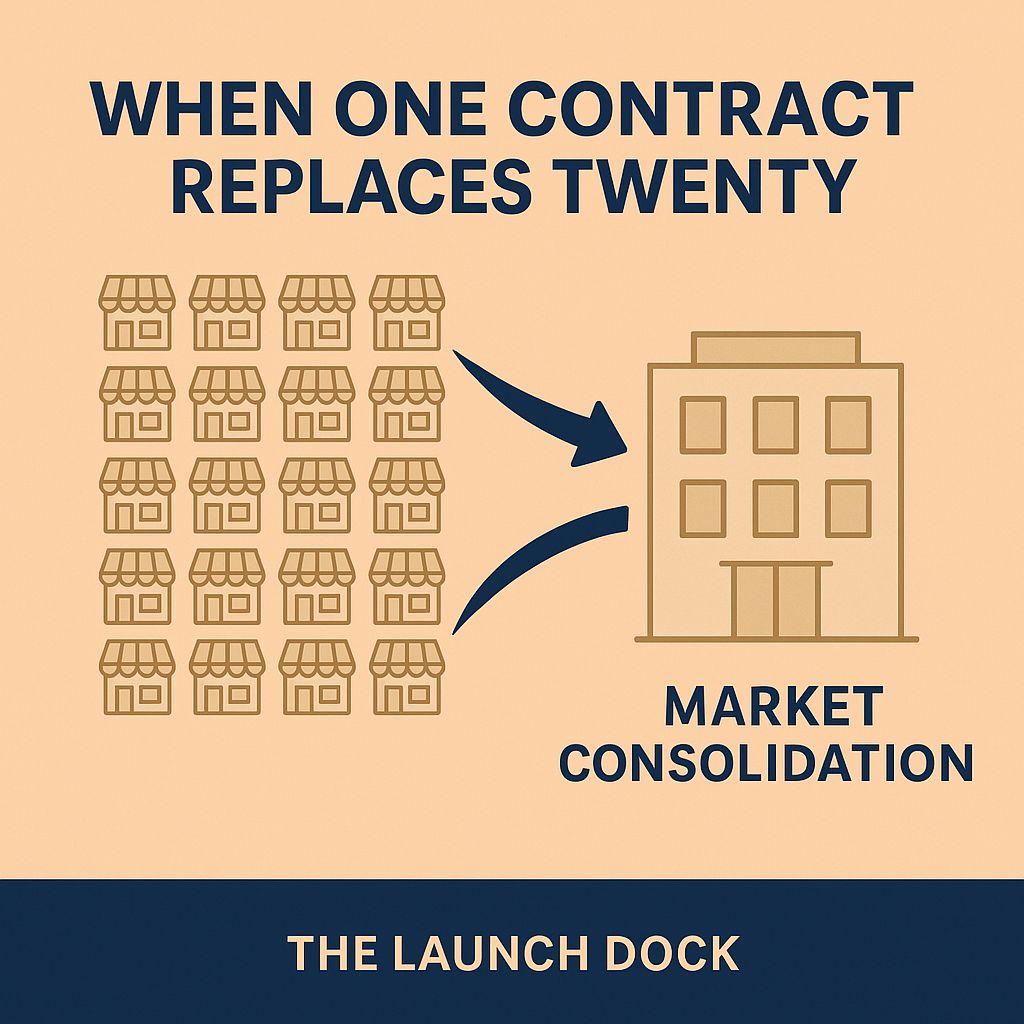- The Launch Dock
- Posts
- The Launch Dock
The Launch Dock
When One Contract Replaces Twenty: How PPPs Accelerate Market Consolidation

Merchant Ship Collective | The Launch Dock
“Where small businesses learn the truth about power, policy, and opportunities that actually matter.”
When One Contract Replaces Twenty: How PPPs Accelerate Market Consolidation
If you’ve ever wondered why it feels harder every year for small businesses to win local work, the answer is bigger than the economy, competition, or timing.
Across the country, something else is happening:
Entire local markets are being consolidated through Public–Private Partnerships (PPPs).
Instead of multiple businesses sharing opportunities, a single master contract is handed to a national company — sometimes for 5, 10, or even 20 years. The “partnership” becomes a gatekeeper, and small businesses lose access overnight.
This issue breaks down exactly how that consolidation happens…
and why it’s not an accident.
What Market Consolidation Looks Like in Real Life
Before we talk policy, let’s make it simple.
Market consolidation happens when:
One company replaces many.
One contract replaces dozens.
One decision eliminates years of opportunity for locals.
It’s not just one industry.
It’s everything:
Building maintenance
Municipal cleaning
HVAC and electrical
Landscaping and snow removal
Food service and catering
Transportation and logistics
IT support and cybersecurity
Printing and marketing
Public health services
School technology and data systems
And once a PPP wins that master contract, the door often stays closed for years.
How PPPs Create Market Consolidation
1. A city or agency bundles multiple services into one “comprehensive contract.”
This is sold as “efficiency.”
But bundling creates contracts that:
Small vendors cannot staff
Local businesses cannot finance
Only national firms can fulfill
This is the first point where the market tips.
2. The PPP wins a long-term contract — often 5–20 years.
Long-term agreements benefit large corporations with:
More capital
Larger labor pipelines
Preexisting government relationships
Advanced proposal teams
Small businesses can’t compete with that scale.
And they shouldn't be expected to.
3. Once awarded, the PPP becomes the exclusive provider.
This eliminates:
Local small business competition
Opportunity diversity
Community wealth circulation
GAO reports show that these “mega-contracts" sharply reduce opportunities for smaller firms and limit competitive entry (Government Accountability Office, 2017).
4. The PPP then integrates proprietary systems.
This is where the trap tightens.
A PPP installs:
Custom software
Special equipment
Private data systems
Vendor-locked tools
Small businesses cannot integrate with these systems without paying fees, meeting unreasonable requirements, or surrendering their autonomy.
This is not efficiency — it’s exclusion.
5. After integration, the PPP controls the entire pipeline.
They become the gatekeeper for:
Hiring
Subcontracting
Data access
Pricing
Vendor eligibility
In many cases, subcontracting is:
Minimal
Unfair
Inaccessible
Or offered at unsustainably low margins
This creates a structural disadvantage for local businesses (U.S. Small Business Administration, 2023).
6. Renewal clauses keep the PPP in place indefinitely.
Some PPP contracts include:
Automatic renewals
Extension clauses
Performance audits conducted by the PPP itself
Exclusivity agreements
By the time the public learns the contract exists, it’s already been renewed.
Real-World Consequences for Small Businesses
Lost Contracts
Businesses that served their communities for decades suddenly lose core revenue.
Shrinking Local Economies
Local dollars are diverted to national corporations with no community roots.
Reduced Consumer Choice
With fewer providers left, prices rise and quality stagnates.
Higher Barriers to Entry
New entrepreneurs face:
More paperwork
Harder certification
Stricter insurance requirements
Higher startup costs
Loss of Community Resilience
When small businesses disappear, towns lose:
Job creation
Skills
Generational wealth
Local expertise
PPP consolidation reshapes entire economic ecosystems — often permanently.
Why Government Allows Consolidation to Continue
Efficiency narrative
Agencies are told a single vendor is easier to manage.
Risk-shifting
Private companies promise to “absorb the liability.”
Budget pressure
PPPs present themselves as cost-savers.
Lobbying
Corporations influence procurement policy more than small businesses ever can.
Emergency use
Emergencies create “temporary exceptions” that become permanent structures (USDA, 2025).
What Small Businesses Can Do
This series will go deeper into the solutions, but here’s your preview:
Advocate for unbundled contracts
Push for local vendor set-asides
Demand transparency in PPP renewal cycles
Track public meetings and planning sessions
Build coalitions with other small businesses
Use public comment periods strategically
Watch for early warning signs like “efficiency studies”
You’re not powerless — you just need information.
That’s why we’re doing this series.
Call to Action
Next week in The Launch Dock:
-How PPP-controlled data systems disadvantage small businesses
-How "proprietary platforms" block local competition
-Why digital infrastructure contracts are the new battleground
-Tools for small businesses to identify and challenge data-based exclusion
Knowledge is the first defense.
Collective power is the second.
And we’re building both — together.
In solidarity,
Lyndsay LaBrier
The Merchant Ship Collective
References
Government Accountability Office. (2017). Animal disease surveillance: Improvements needed in U.S. efforts to control highly pathogenic avian influenza. https://www.gao.gov/products/gao-17-360
United States Department of Agriculture. (2025, February 26). USDA invests $1 billion to combat avian flu and reduce egg prices [Press release]. https://www.usda.gov/about-usda/news/press-releases/2025/02/26/usda-invests-1-billion-combat-avian-flu-and-reduce-egg-prices
U.S. Small Business Administration. (2023). Small business procurement scorecard FY2022. https://www.sba.gov/document/support-small-business-procurement-scorecard
Software sprawl? That’s SaaD.
Software was supposed to make work easier. Instead, most teams are buried under it.
That’s SaaD – Software as a Disservice. Dozens of disconnected tools waste time, duplicate work, and inflate costs.
Rippling changes the story. By unifying HR, IT, and Finance on one platform, Rippling eliminates silos and manual busywork.
HR? One update applies to payroll, benefits, app access, and device provisioning instantly.
Finance? Close the books 7x faster with synced data.
IT? Manage hundreds of devices with a single click.
Companies like Cursor, Clay, and Sierra have already left outdated ways of working behind – gaining clarity, speed, and control.
Don’t get SaaD. Get Rippling.

